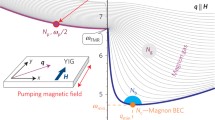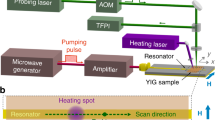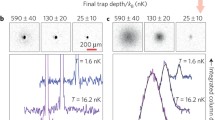Abstract
Coherent precession of trapped Bose–Einstein condensates of magnons is a sensitive probe for magnetic relaxation processes in superfluid \(^3\)He-B down to the lowest achievable temperatures. We use the dependence of the relaxation rate on the density of thermal quasiparticles to implement thermometry in \(^3\)He-B at temperatures below \(300\,\upmu \)K. Unlike popular vibrating wire or quartz tuning fork based thermometers, magnon condensates allow for contactless temperature measurement and make possible an independent in situ determination of the residual zero-temperature relaxation provided by the radiation damping. We use this magnon-condensate-based thermometry to study the thermal impedance of the interface between A and B phases of superfluid \(^3\)He. The magnon condensate is also a sensitive probe of the orbital order-parameter texture. This has allowed us to observe for the first time the non-thermal signature of the annihilation of two AB interfaces.







Similar content being viewed by others
References
G.E. Volovik, The Universe in a Helium Droplet (Oxford University Press, Oxford, 2003)
S. Giorgini, L.P. Pitaevskii, S. Stringari, Rev. Mod. Phys. 80, 1215 (2008)
J.M. Lattimer, M. Prakash, Science 304, 536 (2004)
J.M. Parpia, Phys. Rev. B 32, 7564 (1985)
A.M. Guénault, V. Keith, C.J. Kennedy, S.G. Mussett, G.R. Pickett, J. Low Temp. Phys. 62, 511 (1986)
R. Blaauwgeers, M. Blazkova, M. \({\hat{C}}\)love\({\hat{c}}\)ko, V.B. Eltsov, R. de Graaf, J. Hosio, M. Krusius, D. Schmoranzer, W. Schoepe, L. Skrbek, P. Skyba, R.E. Solntsev, D.E. Zmeev, J. Low Temp. Phys. 146, 537 (2007)
D.I. Bradley, P. Crookston, S.N. Fisher, A. Ganshin, A.M. Guénault, R.P. Haley, M.J. Jackson, G.R. Pickett, R. Schanen, V. Tsepelin, J. Low Temp. Phys. 157, 476 (2009)
C. Bäuerle, Yu.M. Bunkov, S.N. Fisher, H. Godfrin, Phys. Rev. B 57, 14381 (1998)
I.A. Todoschenko, H. Alles, A. Babkin, A.Ya. Parshin, V. Tsepelin, J. Low Temp. Phys. 126, 1449 (2002)
A.I. Ahonen, M. Krusius, M.A. Paalanen, J. Low Temp. Phys. 25, 421 (1976)
J.S. Korhonen, A.D. Gongadze, Z. Janú, Y. Kondo, M. Krusius, Yu.M. Mukharsky, E.V. Thuneberg, Phys. Rev. Lett. 65, 1211 (1990)
R. de Graaf, V.B. Eltsov, P.J. Heikkinen, J.J. Hosio, M. Krusius, J. Low Temp. Phys. 163, 238 (2011)
Yu.M. Bunkov, G.E. Volovik, Phys. Rev. Lett. 98, 265302 (2007)
Yu.M. Bunkov, G.E. Volovik, in Novel Superfluids, vol. 1, ed. by K.H. Bennemann, J.B. Ketterson (Oxford University Press, Oxford, 2013), pp. 253–311. arXiv:1003.4889
Yu.M. Bunkov, S.N. Fisher, A.M. Guénault, G.R. Pickett, Phys. Rev. Lett. 69, 3092 (1992)
D.I. Bradley, D.O. Clubb, S.N. Fisher, A.M. Guénault, C.J. Matthews, G.R. Pickett, P. Skyba, J. Low Temp. Phys. 134, 351 (2004)
S.N. Fisher, G.R. Pickett, P. Skyba, N. Suramlishvili, Phys. Rev. B 86, 024506 (2012)
S. Autti, Yu.M. Bunkov, V.B. Eltsov, P.J. Heikkinen, J.J. Hosio, P. Hunger, M. Krusius, G.E. Volovik, Phys. Rev. Lett. 108, 145303 (2012)
P.J. Heikkinen, S. Autti, V.B. Eltsov, J.J. Hosio, M. Krusius, V.V. Zavjalov, J. Low Temp. Phys. 175, 3 (2014)
D. Einzel, J. Low Temp. Phys. 84, 321 (1991)
A.J. Leggett, M.J. Rice, Phys. Rev. Lett. 20, 586 (1968)
A.J. Leggett, J. Phys. C 3, 448 (1970)
Yu.M. Bunkov, V.V. Dmitriev, A.V. Markelov, Yu.M. Mukharskii, D. Einzel, Phys. Rev. Lett. 65, 867 (1990)
A.V. Markelov, Yu.M. Mukharsky, Physica B 178, 202 (1992)
N. Bloembergen, V. Pound, Phys. Rev. 95, 8 (1954)
D.I. Bradley, S.N. Fisher, A.M. Guénault, R.P. Haley, J. Kopu, H. Martin, G.R. Pickett, J.E. Roberts, V. Tsepelin, J. Low Temp. Phys. 148, 465 (2007)
D.I. Bradley, S.N. Fisher, A.M. Guénault, R.P. Haley, J. Kopu, H. Martin, G.R. Pickett, J.E. Roberts, V. Tsepelin, Nat. Phys. 4, 46 (2008)
I. Hahn, Thermodynamic study of the A-B phase transition in superfluid \(^3\)He: Phase diagram and consequences. Doctoral dissertation, University of Southern California, Los Angeles, USA (1993)
M. Kupka, P. Skyba, Phys. Lett. A 317, 324 (2003)
K. Maki, P. Kumar, Phys. Rev. B 16, 4805 (1977)
D. Rainer, J.W. Serene, Phys. Rev. B 13, 4745 (1976)
J.J. Hosio, V.B. Eltsov, R. de Graaf, M. Krusius, J. Mäkinen, D. Schmoranzer, Phys. Rev. B 84, 224501 (2011)
S.N. Fisher, A.M. Guénault, C.J. Kennedy, G.R. Pickett, Phys. Rev. Lett. 69, 1073 (1992)
D.J. Cousins, S.N. Fisher, A.I. Gregory, G.R. Pickett, N.S. Shaw, Phys. Rev. Lett. 82, 4484 (1999)
I.A. Fomin, JETP Lett. 30, 164 (1979)
D. Vollhard, P. Wöfle, The Superfluid Phases of Helium 3 (Taylor & Francis, London, 1990), p. 385
P.J. Hakonen, M. Krusius, M.M. Salomaa, R.H. Salmelin, J.T. Simola, J. Low Temp. Phys. 76, 225 (1989)
E.V. Thuneberg, J. Low Temp. Phys. 122, 657 (2001)
J. Kopu, J. Low Temp. Phys. 146, 47 (2007)
S.N. Fisher, A.M. Guénault, R.P. Haley, G.R. Pickett, G.N. Plenderleith, P. Skyba, J. Low Temp. Phys. 113, 651 (1998)
M. Bartkowiak, S.N. Fisher, A.M. Guénault, R.P. Haley, G.N. Plenderleith, G.R. Pickett, P. Skyba, Physica B 284, 240 (2000)
S. Yip, A.J. Leggett, Phys. Rev. Lett. 57, 345 (1986)
N.B. Kopnin, Zh. Eksp. Teor. Fiz. 92, 2106 (1987) [Sov. Phys. JETP 65, 1187 (1987)]
M. Arrayás, S.N. Fisher, R.P. Haley, G.R. Pickett, M. Skyba, J. Low Temp. Phys., this issue
M. Bartkowiak, S.N. Fisher, A.M. Guénault, R.P. Haley, G.R. Pickett, G.N. Plenderleith, P. Skyba, Phys. Rev. Lett. 85, 4321 (2000)
H. Martin, Experiments on the thermal transport properties of superfluid \(^3\)He at ultra low temperatures. Doctoral dissertation, Lancaster University, Lancaster, UK (2006)
L. Pogosian, S.-H. Tye, I. Wasserman, M. Wyman, Phys. Rev. D 68, 023506 (2003)
V.B. Eltsov, R. Blaauwgeers, A.P. Finne, M. Krusius, J.J. Ruohio, G.E. Volovik, Physica B 329–332, 96 (2003)
E.V. Thuneberg, Phys. Rev. B 44, 9685 (1991)
Y. Mukharsky, O. Avenel, E. Varoquaux, Phys. Rev. Lett. 92, 210402 (2004)
R.E. Solntsev, R. de Graaf, V.B. Eltsov, R. Hänninen, M. Krusius, J. Low Temp. Phys. 148, 311 (2007)
V.B. Eltsov, R. de Graaf, M. Krusius, D.E. Zmeev, J. Low Temp. Phys. 162, 212 (2011)
V.B. Eltsov, T.W.B. Kibble, M. Krusius, V.M.H. Ruutu, G.E. Volovik, Phys. Rev. Lett. 85, 4793 (2000)
Yu.M. Bunkov, O.D. Timofeevskaya, Phys. Rev. Lett. 80, 4927 (1998)
Y. Kondo, J.S. Korhonen, M. Krusius, V.V. Dmitriev, E.V. Thuneberg, G.E. Volovik, Phys. Rev. Lett. 68, 3331 (1992)
R. Blaauwgeers, V.B. Eltsov, G. Eska, A.P. Finne, R.P. Haley, M. Krusius, J.J. Ruohio, L. Skrbek, G.E. Volovik, Phys. Rev. Lett. 89, 155301 (2002)
I.A. Fomin, Zh. Eksp. Teor. Fiz. 78, 2392 (1980) [Sov. Phys. JETP 51, 1203 (1980)]
Acknowledgments
We thank M. Krusius and P. Skyba for stimulating discussions. This work has been supported in part by the EU 7th Framework Programme (FP7/2007-2013, Grant No. 228464 Microkelvin) and by the Academy of Finland through its LTQ CoE grant (Project No. 250280). The research was done using facilities of the Cryohall infrastructure supported by Aalto University and Academy of Finland. P. J. Heikkinen acknowledges financial support from the Väisälä Foundation of the Finnish Academy of Science and Letters.
Author information
Authors and Affiliations
Corresponding author
Appendix: Calculation of the Spin Diffusion Coefficient
Appendix: Calculation of the Spin Diffusion Coefficient
The expression for the transverse spin diffusion tensor \(D^\perp _{ij}\) [20, 24] is rather complicated and its correct numerical evaluation provides some challenge. Here we describe one recipe for successful calculation of the spin diffusion and also provide a low-temperature approximation from which the origin of the exponential dependence of \(D\) on temperature becomes clear. We discuss only transverse spin diffusion and thus omit the superscript ‘\(\perp \)’ from the following equations.
The theoretical expression for \(D\) is
Here \(v_\mathrm{F}\) is the Fermi velocity, \(\chi '\) is the ratio of susceptibilities of superfluid helium and ideal Fermi gas \(\chi '=\chi _\mathrm{B}/\chi _\mathrm{N0}\), \(\mathbf {k}\) is the wave vector and \(\xi _k\) is the energy of the quasiparticles. The integration is performed over the energy and direction of the wave vector. We also make use of the following notation
where \(\tau \) is the quasiparticle relaxation time and \(\omega _\mathrm{m}= \lambda \omega _\mathrm{L}\) is the Landau molecular field.
The integration over angles in Eq. (9) can be performed analytically, resulting in the following integrals over the energy which can be evaluated numerically,
Here
and
The real part of the expressions in Eq. (10) should be taken as respective components of the diffusion tensor. For numerical stability purposes we perform the integration in Eq. (10) with the same precautions required for calculations of Yosida functions. Namely, to avoid problems at \(T \rightarrow 0\) and \(\xi _k \rightarrow 0\), we substitute the variable \(\xi ' = \tanh (2\xi _k/7)\). If one is interested in the hydrodynamic limit \(\omega _\mathrm{L}\tau \ll 1\), then for \(I_1\) and \(I_2\) more numerically stable approximations are \(I_1 = a/3+b\) and \(I_2 = a/5+b/3\).
Here we are interested in low temperatures, where \(\omega _\mathrm{L}\tau \gg 1\). At these temperatures the values \(|u| \ll 1\) are important in the integrals in Eq. (10). Thus in order to find a low-temperature approximation of \(D\) we expand the integrands in Eq. (10) in powers of \(u\), using the definition of Yosida functions
to perform the integration, and take the limit \(\omega _\mathrm{L}\tau \rightarrow +\infty \). The resulting expressions, with expansion up to \(u^4\), are
where
Note that at least three terms in the expansion over Yosida functions are needed to reach reasonable accuracy even at temperatures below \(0.2 T_\mathrm{c}\). On the other hand, it is enough to keep the zeroth term of the expansion over \((\omega _\mathrm{L}\tau )^{-1}\) (i.e. the \(\tau \)-independent term) for satisfactory calculation of \(D\) at frequencies \(\omega _\mathrm{L}/2\pi \sim 1\,\)MHz and temperatures \(T < 0.25 T_\mathrm{c}\). This has an important consequence for the thermometry. Even if some magnetic relaxation is associated with the sample boundaries and \(\tau \) becomes smaller than in the infinite bulk liquid, the operation of the magnon-condensate thermometer would not be affected provided that \(\omega _\mathrm{L}\tau \gg 1\).
The exponential temperature suppression of \(D\) comes from the behaviour of Yosida functions at low temperatures,
For our pressure 4.1 bar \(F^0_a = -0.73\) and thus
Note that in \(^3\)He-B \(D_{xx} \ne D_{zz}\) in general. This should be taken into account where necessary [57]. For example Eq. (6) should be written as
In this work \(\omega _z\ll \omega _r\) and therefore this correction is not important.
Rights and permissions
About this article
Cite this article
Heikkinen, P.J., Autti, S., Eltsov, V.B. et al. Microkelvin Thermometry with Bose–Einstein Condensates of Magnons and Applications to Studies of the AB Interface in Superfluid \(^3\)He. J Low Temp Phys 175, 681–705 (2014). https://doi.org/10.1007/s10909-014-1173-x
Received:
Accepted:
Published:
Issue Date:
DOI: https://doi.org/10.1007/s10909-014-1173-x




